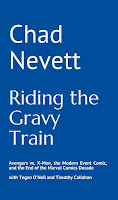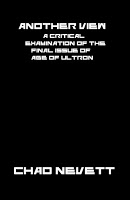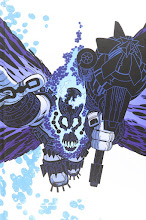[Continuing Art Discussion Month 2010. 31 days, 31 artists, a whole lot of discussion. The explanation behind my choice of comics and the archive can be found here.]
Mek #1-3. Written by Warren Ellis. Pencilled by Steve Rolston. Inked by Al Gordon. Coloured by David Baron.
The first of five three-issue minis written by Ellis whose art I'll be examining. Apparently, Eric Canete was originally meant to drawn this, but that fell through somehow. Going from Canete's angular, intricate art, which I've described as looking like math (Canete draws like math being the line I like to use, because it sounds cool), to Steve Rolston's simpler, more cartoony style seems like a big jump, but I think that that's what required. Anyone working in a similar style to Canete would be seen as Canete Lite, but Rolston is such a big jump and brings such different skills to the project that he can escape Canete's shadow with ease. (Ironically, over the years, Canete's art has moved toward a more cartoony style...)
Mek is about a technological subculture, people who install 'mek' in themselves. Often sex-related or just stuff like artificial eyes or communication devices. Sarissa Leon was one of the people at the forefront of the movement and has since 'sold out' by going to Washington and being an advocate for the movement, something that some think puts her out of touch. She's returned to Sky Road to figure out how her ex-boyfriend died at the hands of 'bad mek' (weaponised mek). Pretty simple.
One of the biggest strengths Rolston brings to the project is his ability to draw human expressions. There's a softness to his characters because of his style that contrasts well with the technology of the book. People look soft and human, the technology looking unnatural and foreign in them to a degree. There's a larger contrast between the flesh and the metal/plastic with Rolston on art.
However, his technology doesn't look as cold or sterile as you'd want either. It's also softer, simpler, more attractive. There's a positive there since you get a better idea as to why people would want to adorn themselves with mek since it doesn't look too offputting. It's an odd contradiction: it looks wrong, but not so wrong that it isn't attractive.
That said, I'm still not sure that Rolston is a good fit for the story. His art has never turned me off really, but it also distances the reader from the world a little too much. He doesn't convey the grime and grit of Sky Road as effectively as you'd want. That cartoony style adds another barrier to the world depicted, which is meant to be like ours only a decade or two down the road at most. Because of that, I think you need a more realistic style that reflects the real world stronger. I don't want you to take that as 'cartoony art is worse than realistic art,' because that's not my intention. I merely think that a more realistic art style would suit the material better. One sequence where a man uses his mek to turn into a dog basically wouldn't have been more effective with a realistic art style.
I'm not sure I've seen Ellis work with an artist with such a cartoony style before, which could be what throws me or makes me back off a little. But, there are moments that seem cribbed from other Ellis comics. A police officer that Sarissa consults with, in one panel, reminds me of the way John Higgins drew Watfod in Hellblazer, smarmy look, rubbing his hand with the other... Sarissa has the strong, elegant look of an Ellis heroine, not entirely dissimilar to Jakita Wagner of Planetary. It's obvious that Rolston examined other Ellis comics to get a feel for the visual style of his books.
As I said, he's fantastic at facial expressions. He uses so few lines to get across exactly what a character is thinking. Sarissa is the main focus of the story, so Rolston spends the most time showing her and a lot of how we understand her is through his visuals. In any given scene, we know what she's feeling because of Rolston's art. She is a little guarded with her emotions, but they still come through because of small, subtle things.
The page layouts are very basic and simple, presenting the story in an easy to read, direct fashion. He's good at panel-to-panel movement and establishing the environment/setting of scenes. In that respect, I don't see many (if any) flaws. David Baron's colours are straight forward and done in solid blocks for the most part with a little bit of progressive shading. Bright colours often, even when it's dark... he definitely adapts to Rolston's cartoony art.
What makes this book stand out is Rolston's art, which is strong, but doesn't necessarily match up tonally. Ellis isn't a cartoony writer often and Mek is a bit more straight forward in its connections to reality, so Rolston is automatically at a disadvantage/place where he needs to prove himself. But, I like his art. His Sarissa is strong and connects with the reader. There's a real softness and humanity in his art that brings out the same quality in Ellis's writing -- something that's usually there, but isn't necessarily highlighted by artists. I can understand people who aren't a fan or think Rolston is a bad fit, but I definitely disagree.
skip to main |
skip to sidebar
"Chad Nevett is the spicy mustard of comics reviews" -- Adam Langton, Lovable Fucker and Chad Nevett's Best Man
About
GraphiContent was a blog featuring comic criticism, commentary, analysis, theory and discussion. Oh, and the odd rant, review or totally random post.
Chad Nevett has a BA in English and political science, and an MA in English Language & Literature--Creative Writing. He was a reviewer for Comic Book Resources, blogger for Comics Should be Good, and writer for 411mania. He resides in Windsor, Ontario with his wife and her cat. He can be reached at chevett13[at]yahoo[dot]ca.
Notable Posts (In Chronological Order)
- The Future is X-Rated: Marvel Boy, the Modern World, and the History of the Marvel Universe
- A Music Video on Paper: The Final Chapter of Codeflesh
- Tony Stark, Futurist
- "All you need is fuck."
- Man v. Superman
- Civil War v. Infinite Crisis
- Building a Better Batman: Grant Morrison's First Year on Batman
- U.S. v. T.H.E.M. with Little Ol' Me Stuck in the Middle
- Mark Millar's Ultimate X-Men
- Building a Better Batreader: Grant Morrison's Second Year on Batman
- Secret Invasion Reading Order (Updated June 29, 2013)
- Top 25 Warren Ellis Comics (Oct. 2009)
- Building a Better Batfamily: Grant Morrison's Third Year on Batman (and Robin)
- You Don't Just Want to Break Me, You Want to Tear Me Apart
- 50 Things I Learned in My Three Years and Four Months as a Reviewer for Comic Book Resources
- Avengers vs. X-Men Reading Order (Updated August 17, 2013)
Notable Collections of Posts (In Semi-Chronological Order)
- Joe Casey Comics Archive
- Countdown to Who Cares?
- The Chad and Steve Q&A Series
- I've Got 52 Problems, but a Bitch ain't One
- Best of 2007
- Hello Cosmic: The Works of Jim Starlin Archive
- Chad's Jackass Comic Creator Interviews from 2001
- The Superman 2000 Pitch (with Tim Callahan)
- Raymond Chandler's "Twelve Notes on the Mystery Story"
- Best of 2008
- Blogathon 2009: Brian Michael Bendis's Avengers
- Best of 2009
- Art Discussion Month 2010
- Five Years Blogging: A Life Well Wasted (with David Brothers)
- Booze, Broads & Bullets: Sin City
- Blogathon 2010: Hellblazer (and Hellblazer Posts Beyond the Blogathon)
- Best of 2010
- 28
- Blogathon 2011: Superhero Comics of the Past Decade
- Best of 2011
- Riding the Gravy Train (Avengers vs. X-Men) Archive
- Blogathon 2013: Comics Critics All-Stars
- Best of 2012
Links
Blogs Worth Reading
-
-
-
House to Astonish Episode 20722 hours ago
-
-
-
The Mighty Crusaders Number Four #031 month ago
-
The Last Thorsday1 month ago
-
Everybody’s Rockin’6 months ago
-
-
Social (Science) Fiction8 months ago
-
The Rest of the Cruise1 year ago
-
-
-
-
Untitled 1:5 years ago
-
Farewell, sweet prince6 years ago
-
Hello World6 years ago
-
-
-
That’s a wrap.9 years ago
-
episode 026: exit the world10 years ago
-
-
Books Read in 201211 years ago
-
Building Stories - Suggested Reading Order11 years ago
-
Final Crisis #715 years ago
-
Riding the Gravy Train: Avengers vs. X-Men, the Modern Event Comic, and the End of the Marvel Comic
Another View: A Critical Reading of the Final Issue of Age of Ultron
GØDLAND CELESTIAL EDITION THREE
Shot in the Face: A Savage Journey to the Heart of Transmetropolitan
Keeping the World Strange: A Planetary Guide
Minutes to Midnight: Twelve Essays on Watchmen
Writing Without Direction: 10 1/2 Short Stories by Canadian Authors under 30
Blog Archive
-
▼
2010
(544)
-
▼
March
(77)
- Art Discussion Month 2010
- Art Discussion Month 2010: The Authority #1-4 by B...
- Art Discussion Month 2010: Planetary/Batman: Night...
- CBR Review: Shuddertown #1
- CBR Review: Supergod #3
- Art Discussion Month 2010: Planetary/JLA: Terra Oc...
- Five Years Blogging: A Life Well Wasted
- The Splash Page Podcast Episode 10.2
- Art Discussion Month 2010: Planetary/The Authority...
- The Splash Page Podcast Episode 10.1
- Five Years Blogging: A Life Well Wasted 10
- Five Years Blogging: A Life Well Wasted 08
- Art Discussion Month 2010: Ministry of Space #1-3 ...
- CBR Review: Captain America #604
- Art Discussion Month 2010: Red #1-3 by Cully Hamner
- Five Years Blogging: A Life Well Wasted 06
- Art Discussion Month 2010: Tokyo Storm Warning #1-...
- Quickie Reviews (Mar 24 2010)
- Five Years Blogging: A Life Well Wasted 04
- CBR Review: Avengers: The Initiative #34
- CBR Review: Uncanny X-Men #522
- CBR Review: The Incredibles #7
- Art Discussion Month 2010: Reload #1-3 by Paul Gulacy
- Five Years Blogging: A Life Well Wasted 02
- CBR Review: Breaking into Comics the Marvel Way #2
- Art Discussion Month 2010: Mek #1-3 by Steve Rolston
- Art Discussion Month 2010: Global Frequency #12 by...
- The Splash Page Podcast Episode 9.2
- Art Discussion Month 2010: Global Frequency #11 by...
- The Splash Page Podcast Episode 9.1
- Art Discussion Month 2010: Global Frequency #10 by...
- Art Discussion Month 2010: Global Frequency #9 by ...
- CBR Review: Battlefields: The Firefly and His Maje...
- CBR Review: Dark Avengers #15
- CBR Review: Nova #35
- CBR Review: Realm of Kings: Imperial Guard #5
- Art Discussion Month 2010: Global Frequency #8 by ...
- CBR Review: Guardians of the Galaxy #24
- Art Discussion Month 2010: Global Frequency #7 by ...
- Quickie Reviews (Mar 17 2010)
- Art Discussion Month 2010: Global Frequency #6 by ...
- CBR Review: Breaking into Comics the Marvel Way #1
- CBR Review: Daytripper #4
- Art Discussion Month 2010: Global Frequency #5 by ...
- The Splash Page Podcast Episode 8.2
- CBR Review: Punishermax #5
- Art Discussion Month 2010: Global Frequency #4 by ...
- The Splash Page Podcast Episode 8.1
- Art Discussion Month 2010: Global Frequency #3 by ...
- Art Discussion Month 2010: Global Frequency #2 by ...
- CBR Review: S.W.O.R.D. #5
- Fuck Me?
- CBR Review: The Twelve: Spearhead #1
- Art Discussion Month 2010: Global Frequency #1 by ...
- Is It Just Children?
- Art Discussion Month: Simon Spector #1 by Jacen Bu...
- CBR Review: Prelude to Deadpool Corps #2
- Quickie Reviews (Mar 10 2010)
- Art Discussion Month 2010: Quit City #1 by Laurenn...
- CBR Review: Detective Comics #862
- CBR Review: Forgetless #3
- Art Discussion Month 2010: Frank Ironwine #1 by Ca...
- The Splash Page Podcast Episode 7.2
- Art Discussion Month 2010: Angel Stomp Future #1 b...
- The Splash Page Podcast Episode 7.1
- Art Discussion Month 2010: Hellblazer #143 by Marc...
- CBR Review: Sparta, U.S.A. #1
- Art Discussion Month 2010: Hellblazer #142.2 by Ja...
- CBR Review: Stephen King's "N." #1
- CBR Review: Mighty Avengers #34
- Art Discussion Month 2010: Hellblazer #142.1 by Ja...
- CBR Review: First Wave #1
- Art Discussion Month 2010: Hellblazer #141 by Tim ...
- Quickie Reviews and Michelle's Covers Thoughts (Ma...
- Art Discussion Month 2010: Hellblazer #140 by Fran...
- Art Discussion Month 2010: Hellblazer #134-139 by ...
- The Splash Page Podcast Episode 6.2
-
▼
March
(77)






